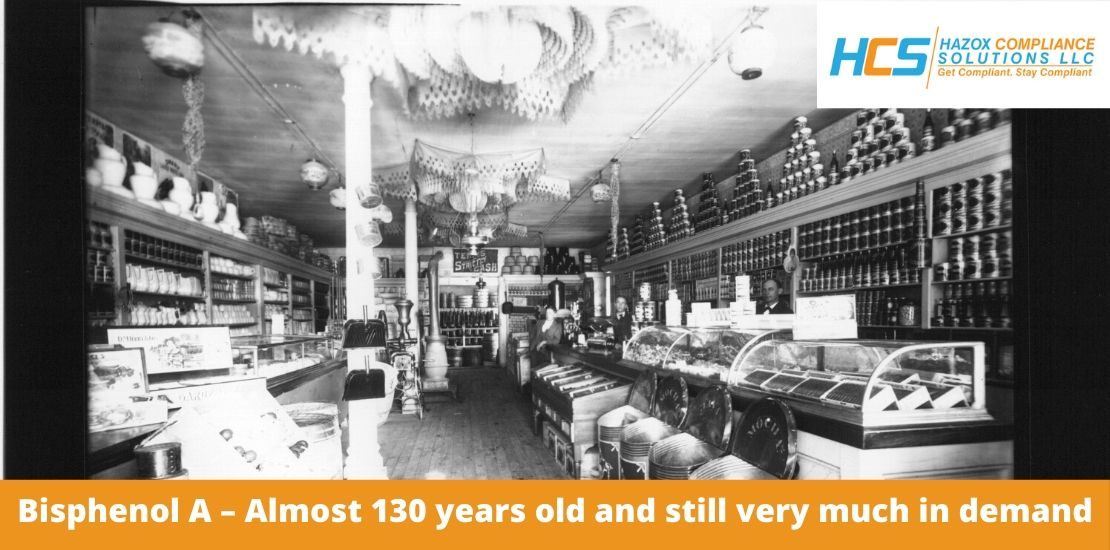- February 25, 2020
- Posted by: admin
- Category: Blogs

Some things don’t go out of date, and Bisphenol A is one of them. Many chemicals come and go, but the curing properties attributed to BPA make it an ideal component in a diverse range of applications.
If you have missed the first article in the series, where we introduced you to the chemical BPA, you can catch up here (https://www.hazoxinc.com/bisphenol-a-an-old-chemical-with-new-restrictions/).
There has been a lot of controversy over the years about the use of BPA in products and currently many of the BPA-free alternatives are showing similar trends in health effects.
In this article, we are going to look at the history of BPA from its first synthesis to the current day.
Bisphenol A (BPA) was first synthesized in 1891. Years later, in the 1930s, it was discovered to be used as an artificial estrogen, which was the first indication of endocrine disruption. In 1940 to 1950 it was discovered that it could be used to make a plastic called polycarbonate and epoxy resins used as liner for food cans.
Until the late 1980s it was still considered a very safe substance even in high concentrations. So much so that by 1988 the EPA’s safety standard for BPA was up to 25 times higher than harmful levels.
In 1997 it was discovered that exposure to low levels of BPA damages the prostate. This is the first of many academic laboratory studies that will find harmful effects of BPA at exposure levels far below the government’s safety standards for BPA, in the range of what is found in people. Over the next 11 years, BPA is linked to breast and prostate damage, early puberty, behavioral problems, and other effects at levels up to 25 times lower than the “safe” EPA dose.
In 1999, BPA was found to leak from bottles when they are heated, prompting a new debate about the safety of baby exposure. Although the FDA maintains its position and ignores emerging evidence of BPA toxicity at low doses.
In 2002, BPA was found to damage the brain and behavior in a study of rodents even at doses 40 times lower than those allowed by the EPA.
Due to pressure from the consumers, the government seriously evaluated the toxicity of BPA at low doses in 2003-2006. However, flaws were revealed in the selection process of the evaluating personnel and the exclusion of important evidence. Conflicts of interest continue during 2007 and no progress had been made in detecting risks associated with BPA. In late 2007 and early 2008 the position of the FDA and infant formula manufacturers on the safety of BPA for infants was in question, and Congress was investigating the facts.
2008 was a very important year for the disclosure of health risks associated with BPA. Dozens of studies published in the literature linked exposure to BPA at extremely low levels to a range of adverse health effects, including breast and prostate cancer, early puberty, infertility, obesity and behavioral problems. (https://www.ncbi.nlm.nih.gov/pmc/articles/PMC2151845/). The FDA had not used any of these studies in its assessments of the safety of BPA and maintained its conservative approach. That same year Wal-Mart and other retailers pulled BPA products from the shelves and Congress asked the FDA to re-evaluate its safety standards for BPA. For its part, Canada became the first country to complete a comprehensive assessment of human exposure to BPA and to take steps to reduce exposure nationwide.Manufacturers of products for infants and newborns were the first to switch to safe alternatives for their products.
In 2009, more than 20 states introduced bills to reduce children’s exposure to BPA, and polycarbonate sports drink bottles were also found to increase BPA levels in the body. Studies raised concerns about the intensity of exposure of bottle-fed infants who may ingest all their food from polycarbonate bottles containing BPA (https://www.ewg.org/research/bisphenol).
The year 2010 saw further progress on BPA regulations at the federal and state levels. Canada banned BPA once and for all and progress continued to be made in several states. Europe joined the trend and the German government restricted BPA in Germany by announcing specific risk reduction measures to the EU. Denmark, Australia, the United Kingdom and Ireland also followed in restricting BPA in baby products and general consumer canned goods.(https://www.foodsafetynews.com/2010/06/germany-reccommends-limiting-bpa/).
In 2011, the European Union bans BPA in baby bottles and China proposed a ban on BPA in all containers of baby food or drinks. (https://ec.europa.eu/commission/presscorner/detail/en/IP_11_664)
In 2012, the FDA finally decided to ban BPA in food and beverage containers, after more than 11 states banned BPA in children’s bottles and cups. (https://www.federalregister.gov/documents/2012/07/17/2012-17366/indirect-food-additives-polymers#p-3).
France voted to ban BPA from all food packaging by Jan. 1, 2014, and from baby and toddler food packaging, materials and containers by Jan. 1, 2013.
This long history just makes clear that behind many of the toxic chemicals we are exposed to, there are many public and private initiatives that seek to support health and focus on providing us with valuable information that will help us make appropriate decisions to preserve our health and that of our family.
Tomorrows article will look at the BPA Market and how is BPA used in the marketplace today.
If you liked our article, please give us a Like and follow us on:
Facebook: https://www.facebook.com/HazoxComplianceSolutions
Twitter https://twitter.com/Hazox_Inc
LinkedIn https://www.linkedin.com/company/hazoxcompliancesolutions
Youtube: https://www.youtube.com/channel/UCIeBucyOUEtQFSAymS3TwQQ
